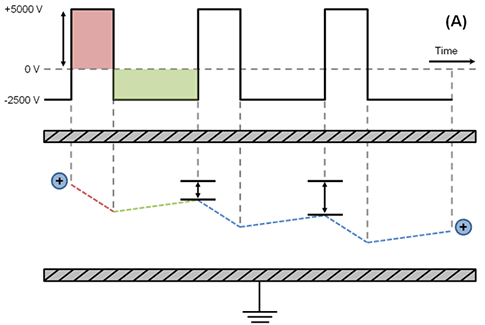High-Field Asymmetric Waveform Ion Mobility Spectrometry (FAIMS)
Overview
One of the primary focuses of the Yost Research Group is developing novel instrumentation and methodologies for High-Field Asymmetric Waveform Ion Mobility Spectrometry (FAIMS). FAIMS can be performed on a standalone device, or, more prominently, coupled to a mass spectrometer (MS). FAIMS is a separation technique which allows continuous sample introduction, enabling direct, real-time analysis.
FAIMS (or differential mobility spectrometry, DMS) involves separation based on the inherent differences in an ion’s mobility in high and low electric fields, and can be performed at atmospheric pressure and room temperature (unlike its chromatographic counterparts). In conventional ion mobility spectrometry (IMS), ions are pulsed through a drift tube by an applied electric field in the presence of a buffer gas which opposes the ion’s motion. As the field is held constant, the velocity, and therefore the mobility, of an ion is dependent upon its mass, charge, size, and shape as it traverses the drift tube and collides with the buffer gas molecules. This is demonstrated by the following equation:
![]()
where ν is the velocity of the ion, Κ is the mobility of the ion, and Ε is the electric field strength. Therefore, the migration time through the tube is characteristic of each ion.
However in FAIMS, the applied RF voltage is alternated between a high and low field as the ions are swept through the cell by a carrier gas. As the electric field increases in intensity, the velocity does not increase proportionally with the field strength; thus mobility becomes field-dependent at higher electric fields. At such higher fields (above 10,000 V/cm, as opposed to the 200 V/cm considered low-field), the mobility may now be expressed by the following equation:
![]()
where Κh is the high-field mobility, Κ is the low-field mobility, α and ß are compound specific values which account for high-field mobility effect, N is the gas number density of carrier gas, and Ε is the electric field strength. This distinct difference in mobility between high and low fields, Κh/Κ, is the basic operational principle of FAIMS.
FAIMS is typically performed by utilizing one of two cell geometries: curved or planar. To best illustrate the separation principles of FAIMS, a planar geometry cell is discussed, however, both geometries are fundamentally similar. Separation is achieved by maintaining one electrode at (or near) ground, while applying a waveform to the other electrode, as described by the application of a dispersion voltage to create a high-field environment for a short amount of time, before applying the opposite polarity voltage to create a low-field environment for a greater amount of time (A). While subjected to a high field, an ion has a greater mobility, causing it to drift faster toward the lower plate. When the field is switched, the ion’s mobility decreases, and it drifts toward the upper plate. Due to the asymmetry of the waveform, there will be a net displacement of the ion after one period of the waveform as the ion will not cover the same vertical distance when in low-field as it did in high-field. With each continuous period, the ion will move closer and closer to one of the electrodes until it makes contact and is annihilated.
To compensate for this drift, specific ions of interest can be made to reach the detector by applying a secondary DC voltage to the electrodes, called the compensation voltage, as seen in (B).
Ion Mobility
Overview
Building on our experience with FAIMS, the Yost Research Group has now branched out to include Drift Tube Ion Mobility (DT-IMS) with the addition of an Agilent 6560 IM-QTOF-LC/MS. DT-IMS utilizes a constant electric field across the length of a low pressure drift cell; the ion drift velocity (vd) is proportional to the electric field and the mobility coefficient of the ion (K), as follows:
Vd = KE
As ions tumble through this low pressure environment, they undergo collisions with drift gas molecules. Ultimately, the ions are separated based on size, shape, and charge, with the smaller molecules experiencing fewer collisions and thus traveling through the cell more quickly. By detecting these ions as they travel through the drift tube, either with a simple Faraday cup detector or mass spectrometer, a drift time spectrum is created, as seen below:
By measuring the adjusted drift time for a particular ion (and taking into account such factors as drift tube pressure, temperature, and drift gas composition), the rotationally averaged collision cross section (CCS) can be calculated, as follows:
Ion mobility offers several advantages when coupled with mass spectrometry, including the ability to separate isobaric and isomeric compounds that might not be resolved with mass spectrometry alone. Plotting drift time versus m/z allows us to create three dimensional heat maps, as seen below:
The focus of ion mobility in our group revolves around improving metabolomics studies. Specifically, we use IMS with LC-MS/MS to improve metabolite detection in complex matrices, separate isomeric compounds prior to MS, and characterize small molecules based on their collision cross sections. Additionally, our group is studying the fundamentals of small molecule interactions in the gas phase, to improve the separation of chiral compounds.



